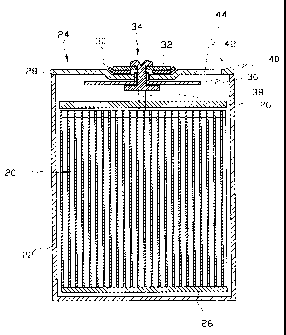Some of the information on this Web page has been provided by external sources. The Government of Canada is not responsible for the accuracy, reliability or currency of the information supplied by external sources. Users wishing to rely upon this information should consult directly with the source of the information. Content provided by external sources is not subject to official languages, privacy and accessibility requirements.
Any discrepancies in the text and image of the Claims and Abstract are due to differing posting times. Text of the Claims and Abstract are posted:
| (12) Patent: | (11) CA 2272428 |
|---|---|
| (54) English Title: | SECONDARY BATTERY |
| (54) French Title: | ACCUMULATEUR ELECTRIQUE |
| Status: | Term Expired - Post Grant Beyond Limit |
| (51) International Patent Classification (IPC): |
|
|---|---|
| (72) Inventors : |
|
| (73) Owners : |
|
| (71) Applicants : |
|
| (74) Agent: | MOFFAT & CO. |
| (74) Associate agent: | |
| (45) Issued: | 2007-01-09 |
| (86) PCT Filing Date: | 1998-04-06 |
| (87) Open to Public Inspection: | 1999-06-03 |
| Examination requested: | 2002-11-28 |
| Availability of licence: | N/A |
| Dedicated to the Public: | N/A |
| (25) Language of filing: | English |
| Patent Cooperation Treaty (PCT): | Yes |
|---|---|
| (86) PCT Filing Number: | PCT/KR1998/000082 |
| (87) International Publication Number: | KR1998000082 |
| (85) National Entry: | 1999-05-18 |
| (30) Application Priority Data: | ||||||
|---|---|---|---|---|---|---|
|
A secondary battery comprises a can into which an electrode
assembly is inserted, a cap assembly mounted to an opening of the can; and
an electrolyte injection hole formed on at least one of the can and cap
assembly, and a safety member to close the electrolyte injection hole. The
electrolyte injection hole is formed on a negative portion of the cap
assembly. The safety member is inserted into and welded on the
electrolyte injection hole.
Accumulateur électrique composé d'un récipient métallique dans lequel est introduit un ensemble électrode, d'un ensemble couvercle monté sur une ouverture du récipient métallique et d'un orifice d'injection d'électrolyte situé sur au moins un du récipient métallique et de l'ensemble couvercle, ainsi que d'un élément de sécurité servant à fermer ledit orifice. Cet orifice est placé sur une partie négative de l'ensemble couvercle. L'élément de sécurité est introduit dans l'orifice d'injection d'électrolyte et soudé à ce dernier.
Note: Claims are shown in the official language in which they were submitted.
Note: Descriptions are shown in the official language in which they were submitted.

2024-08-01:As part of the Next Generation Patents (NGP) transition, the Canadian Patents Database (CPD) now contains a more detailed Event History, which replicates the Event Log of our new back-office solution.
Please note that "Inactive:" events refers to events no longer in use in our new back-office solution.
For a clearer understanding of the status of the application/patent presented on this page, the site Disclaimer , as well as the definitions for Patent , Event History , Maintenance Fee and Payment History should be consulted.
| Description | Date |
|---|---|
| Inactive: Expired (new Act pat) | 2018-04-06 |
| Grant by Issuance | 2007-01-09 |
| Inactive: Cover page published | 2007-01-08 |
| Inactive: Final fee received | 2006-11-02 |
| Pre-grant | 2006-11-02 |
| Notice of Allowance is Issued | 2006-09-21 |
| Letter Sent | 2006-09-21 |
| Notice of Allowance is Issued | 2006-09-21 |
| Inactive: Approved for allowance (AFA) | 2006-09-12 |
| Amendment Received - Voluntary Amendment | 2006-07-24 |
| Inactive: S.30(2) Rules - Examiner requisition | 2006-01-26 |
| Amendment Received - Voluntary Amendment | 2005-10-28 |
| Inactive: S.30(2) Rules - Examiner requisition | 2005-04-28 |
| Letter Sent | 2002-12-18 |
| Request for Examination Requirements Determined Compliant | 2002-11-28 |
| All Requirements for Examination Determined Compliant | 2002-11-28 |
| Request for Examination Received | 2002-11-28 |
| Letter Sent | 1999-08-18 |
| Inactive: Cover page published | 1999-08-11 |
| Inactive: Single transfer | 1999-07-15 |
| Inactive: IPC assigned | 1999-07-14 |
| Inactive: IPC assigned | 1999-07-14 |
| Inactive: First IPC assigned | 1999-07-14 |
| Inactive: Courtesy letter - Evidence | 1999-06-29 |
| Inactive: Notice - National entry - No RFE | 1999-06-23 |
| Application Received - PCT | 1999-06-18 |
| Application Published (Open to Public Inspection) | 1999-06-03 |
There is no abandonment history.
The last payment was received on 2006-02-13
Note : If the full payment has not been received on or before the date indicated, a further fee may be required which may be one of the following
Patent fees are adjusted on the 1st of January every year. The amounts above are the current amounts if received by December 31 of the current year.
Please refer to the CIPO
Patent Fees
web page to see all current fee amounts.
Note: Records showing the ownership history in alphabetical order.
| Current Owners on Record |
|---|
| SAMSUNG DISPLAY DEVICES CO. LTD. |
| Past Owners on Record |
|---|
| UN SICK PARK |
| YOUNG BAE SONG |